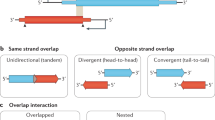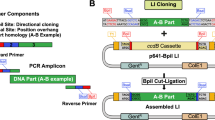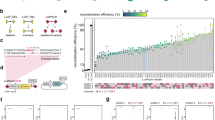Abstract
We present a methodology, termed incremental truncation for the creation of hybrid enzymes (ITCHY), that creates combinatorial fusion libraries between genes in a manner that is independent of DNA homology. We compared the ability of ITCHY and DNA shuffling to create interspecies fusion libraries between fragments of the Escherichia coli and human glycinamide ribonucleotide transformylase genes, which have only 50% identity on the DNA level. Sequencing of several randomly selected positives from each library illustrated that ITCHY identified a more diverse set of active fusion points including those in regions of nonhomology and those with crossover points that diverged from the sequence alignment. Furthermore, some of the hybrids found by ITCHY that were fused at nonhomologous locations had activities that were greater than or equal to the activity of the hybrids found by DNA shuffling.
This is a preview of subscription content, access via your institution
Access options
Subscribe to this journal
Receive 12 print issues and online access
$209.00 per year
only $17.42 per issue
Buy this article
- Purchase on Springer Link
- Instant access to full article PDF
Prices may be subject to local taxes which are calculated during checkout




Similar content being viewed by others
References
Stemmer, W.P.C. D.N.A shuffling by random fragmentation and reassembly: in vitro recombination for molecular evolution. Proc. Natl. Acad. Sci. USA 91, 10747–10751 (1994).
Crameri, A., Raillard, S.-A., Bermudez, E. & Stemmer, W.P.C. DNA shuffling of a family of genes from diverse species accelerates directed evolution. Nature 391, 288– 291 (1998).
Zhao, H., Giver, L., Shao, Z. & Arnold, F.H. Molecular evolution by staggered extension process (StEP) in vitro recombination. Nat. Biotechnol. 16, 258–261 (1998).
Shao, Z., Zhao, H., Giver, L. & Arnold, F.H. Random-priming in vitro recombination: an effective tool for directed evolution. Nucleic Acids Res. 26, 681–683 (1998).
Joo, H., Lin, Z. & Arnold, F.H. Laboratory evolution of peroxide-mediated cytochrome P450 hydroxylation. Nature 399, 670– 673 (1999).
Stemmer, W.P.C. Rapid evolution of a protein in vitro by DNA shuffling. Nature 370, 389–391 ( 1994).
Arnold, F.H. & Moore, J.C. Optimizing industrial enzymes by directed evolution. Adv. Biochem. Eng. Biotechnol. 58, 1–14 (1997).
Proba, K., Wörn, A., Honegger, A. & Plückthun, A. Antibody scFv fragments without disulfide bonds made by molecular evolution. J. Mol. Biol 275, 245– 253 (1998).
Giver, L., Gershenson, A., Freskgard, P.-O. & Arnold, F.H. Directed evolution of a thermostable esterase. Proc. Natl. Acad. Sci. USA 95, 12809–12813 (1998).
Zhao, H. & Arnold, F.H. Directed evolution converts subtilisin E into a functional equivalent of thermitase. Protein Eng. 12, 47–53 (1999).
Buchholz, F., Angrand, P.-O. & Stewart, A.F. Improved properties of FLP recombinase evolved by cycling mutagenesis. Nat. Biotechnol. 16, 657–662 (1998).
Crameri, A., Whitehorn, E.A., Tate, E. & Stemmer, W.P.C. Improved green fluorescent protein by molecular evolution using DNA shuffling. Nat. Biotechnol. 14, 315– 319 (1996).
Zhang, J.-H., Dawes, G. & Stemmer, W.P.C. Directed evolution of a fucosidase from a galactosidase by DNA shuffling and screening. Proc. Natl. Acad. Sci. USA 94, 4504–4509 (1997).
Bogorad, L.D. & Deem, M.W. A hierarchical approach to protein molecular evolution. Proc. Natl. Acad. Sci. USA 96, 2591–2595 (1999).
Ostermeier, M., Nixon, A.E., Shim, J.H. & Benkovic, S.J. Combinatorial protein engineering by incremental truncation. Proc. Natl. Acad. Sci. USA 96, 3562–3567 ( 1999).
Ostermeier, M., Nixon, A.E. & Benkovic, S.J. Incremental truncation as a strategy in the engineering of novel biocatalysts. Bioorg. Med. Chem. 7, 2139–2144 (1999).
Tomb, J.-F. & Barcak, G.J. Regulating the 3′-5′ activity of exonuclease III by varying the sodium chloride concentration. Biotechniques 7, 932–933 (1989).
Wu, R. et al. Synchronous digestion of SV40 DNA by exonuclease III. Biochemistry 15, 734–740 ( 1976).
Smith, J.M. & Daum, H.A. Identification and nucleotide sequence of a gene encoding 5′-phosphoribosylglycinamide transformylase in Escherichia coli K12. J. Biol. Chem. 262, 10565–10569 (1987).
Aimi, J., Qiu, H., Williams, J., Zalkin, H. & Dixon, J.E. De novo purine nucleotide biosynthesis: cloning of human and avian cDNAs encoding the trifunctional glycinamide ribonucleotide synthetase-aminoimidazole ribonucleotide synthetase-glycinamide ribonucleotide transformylase by functional complementation in E. coli. Nucleic Acids Res. 18, 6665–6672 (1990).
Caperelli, C.A. & Giroux, E.L. The human glycinamide ribonucleotide transformylase domain: purification, characterization, and kinetic mechanism. Arch. Biochem. Biophys. 341, 98–103 (1997).
Kan, C.-C. et al.. Heterologous expression and purification of active human phosphoribosylglycinamide formyltrasnferase as a single domain. J. Protein. Chem. 11, 467–473 (1992).
Varney, M.D. et al. Protein structure based design, synthesis, and biological evaluation of 5-thia-2,6-diamino-4(3H)-oxopyrimidines: potent inhibitors of glycinamide ribonucleotide transformylase with potent cell growth inhibition. J. Med. Chem. 40, 2502–2524 (1997).
Bernstein, F.C. et al. The protein data bank: a computer-based archival file for macromolecular structures. J. Mol. Biol 112, 535– 542 (1977).
Ho, S.N., Hunt, H.D., Horton, R.M., Pullen, J.K. & Pease, L.R. Site-directed mutagenesis by overlap extension using the polymerase chain reaction. Gene 77, 51–59 (1989).
Hallet, B., Sherratt, D.J. & Hayes, F. Pentapeptide scanning mutagenesis: random insertion of a variable five amino acid cassette in a target protein. Nucleic Acids Res. 25, 1866–1867 (1997).
Zebala, J. & Barany, F. Mapping catalytically important regions of an enzyme using two-codon insertion mutagenesis: a case study correlating β-lactamase mutants with the three-dimensional structure. Gene 100, 51–57 (1991).
Betton, J.-M., Jacob, J.P., Hofnung, M. & Broome-Smith, J.K. Creating a bifunctional protein by insertion of β-lactamase into the maltodextrin-binding protein. Nat. Biotechnol. 15, 1276– 1279 (1997).
Biondi, R.M., Baehler, P.J., Reymond, C.D. & Véron, M. Random insertion of GFP into the cAMP-dependent protein kinase regulatory subunit from Dictyostelium discoideum. Nucleic Acids Res. 26, 4946–4952 ( 1998).
Warren, M.S., Marolewski, A.E. & Benkovic, S.J. A rapid screen of active site mutants in glycinamide ribonucleotide transformylase. Biochemistry 35, 8855–8862 (1996).
Almassy, R.J., Janson, C.A., Kan, C.-C. & Hostomska, Z. Structures of apo and complexed Escherichia coli glycinamide ribonucleotide transformylase. Proc. Natl. Acad. Sci. USA 89, 6114– 6118 (1992).
Hopfner, K.-P. et al. New enzyme lineages by subdomain shuffling. Proc. Natl. Acad. Sci. USA 95, 9813–9818 (1998).
Nixon, A.E., Warren, M.S. & Benkovic, S.J. Assembly of an active enzyme by the linkage of two protein modules. Proc. Natl. Acad. Sci. USA 94, 1069–1073 (1997).
Nixon, A.E., Ostermeier, M. & Benkovic, S.J. Hybrid enzymes: manipulating enzyme design. Trends Biotechnol. 16, 258–264 (1998).
Zhao, H. & Arnold, F.H. Optimization of DNA shuffling for high fidelity. Nucleic Acids Res. 25, 1307 –1308 (1997).
Shim, J.H. & Benkovic, S.J. Evaluation of the kinetic mechanism of Escherichia coli glycinamide ribonucleotide transformylase. Biochemistry 37, 8776–8782 (1998).
Acknowledgements
We thank A.E. Nixon, C.P. Scott, and S.M. Firestine for many helpful discussions, and L.T. Gooljarsingh for purified GARS–AIRS–GART. This work was supported in part by National Institutes of Health Grant GM24129 (S.J.B.) and National Institutes of Health Postdoctoral Fellowship GM18560 (M.O.).
Author information
Authors and Affiliations
Corresponding author
Rights and permissions
About this article
Cite this article
Ostermeier, M., Shim, J. & Benkovic, S. A combinatorial approach to hybrid enzymes independent of DNA homology . Nat Biotechnol 17, 1205–1209 (1999). https://doi.org/10.1038/70754
Received:
Accepted:
Issue Date:
DOI: https://doi.org/10.1038/70754
This article is cited by
-
Comprehensive deletion landscape of CRISPR-Cas9 identifies minimal RNA-guided DNA-binding modules
Nature Communications (2021)
-
Synthetic evolution
Nature Biotechnology (2019)
-
Methods for the directed evolution of proteins
Nature Reviews Genetics (2015)
-
Algorithms for optimizing cross-overs in DNA shuffling
BMC Bioinformatics (2012)
-
Exploring protein fitness landscapes by directed evolution
Nature Reviews Molecular Cell Biology (2009)



